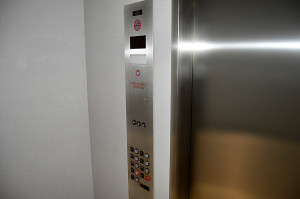
Earthquake Elevator
July 18, 2019
Elevator Installation Difficult
August 19, 2019Hold the Elevator Door Please!

We have all been there. The hallway is crowded and everybody has got somewhere to be. The elevator chimes and the doors of the express elevator glide swiftly open. Everyone inside the car shuffles up against the laminate covered walls and as there is some room available, everyone files in. Like sardines in a can you, and everyone else wedges together. Not since the 1950’s craze of packing a phone booth have quarters been so tight.
The elevator dings again, as the doors begin to move, everyone inhales and holds to garner just a little more space and then you hear a quiet cry from down the hall, “Hold the elevator please!”
(Below is video that shows an actual rescue from a similar scenario.)
We are a polite people. Some would say we are polite to a fault.
A hand reflexively shoots out of the crammed pack of passengers, so firmly squeezed together and brings the doors to a stop just inches from closing. Everyone inhales just a little more and a wisp of a girl slowly sidles in with head down and apologies flying. What could one, one-hundred pound person harm? There is no way this straw of an individual will break the back of the elevator. Its impossible.
But impossible things do happen and this time the elevator doors don’t feel so swift in their closing, almost as if this robotic object senses there maybe just one too many person on board. It’s groans of complaints however go unheeded as the doors grind closed. Then with a shudder and thunk the car starts creeping downward to the lobby.
This scenario plays itself out countless times, in countless elevators, in countless buildings everyday. But have you ever thought that sometimes enough weight is a enough weight? What happens when you overload the camel’s back?
Well as with most things there are a few variables:
- First, the elevator might have an overload sensor. Handy thing to have. If it does, no worries the elevator simply won’t budge. Sometimes there is a buzzer to let you know its not going anywhere and other times a light or message on the position indicator will flash. Most elevators do not have this sensing capability though and so they do not react at all.
- The next possible scenario is a bit more dire for the elevator and the passengers. Even though the elevator car may be ignorant of the total weight inside, the motor is a different circumstance all together. A mild symptom of overloading is that the car will have trouble leveling to the floor. A little freaky but at least you are on the right floor. Consider bullet dodged.
- Going up! If the elevator is going up, the doors may close and then the elevator as it starts to move will recognize the limits have been breached or it is simply being overworked and will shut down. This is one way people get stuck and if it is an express elevator, you may get trapped between floors and that can be similar to the elevator in the above video, a hundred feet or more and several hours from any escape. Here is another video of the worst case scenario in an express elevator.
- Going down! If the elevator is going down, the motor may not be strong enough to keep the speed under control. See a traction elevator operates on balance. There are counter weights that are supposed to be equal to (or at least close to) the weight of the fully loaded car. Anyone with sixth grade science under their belt can tell you with equal weight the elevator motor is not lifting the full load. It is balanced. But if the car is way too heavy, the car could travel too fast and trip one of 3 over-speed detection systems and the car will come to a grinding halt by means of the brake, rope gripper or the free-fall safety devise or any combination of the all three.
- If the motor is okay with too much weight, the elevator cables (otherwise called ropes) might not be. Now the ropes won’t break and drop everyone to their deaths, that is a myth and has happened only once in the US when a plane hit the Empire State Building and unbelievably cut all the ropes at once (click here for the story). The aforementioned detection system will see to it that the elevator won’t fall, but overweight cables can slip over the main sheaves. Instead of a controlled ride the slippage will cause the automatic stopping systems to kick in and stuck you will be.
Beyond that catastrophic failure is an extremely, extremely rare possibility. But, why take the chance. You really have two options, either be polite and get out of the elevator and let the other passengers join in on the crowded car or suck it in a little more and get ready for a possible rough ride and a potential long wait on the fire department or an elevator technician. I know which one I am choosing every time.

